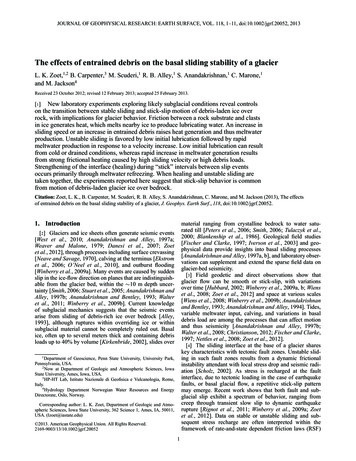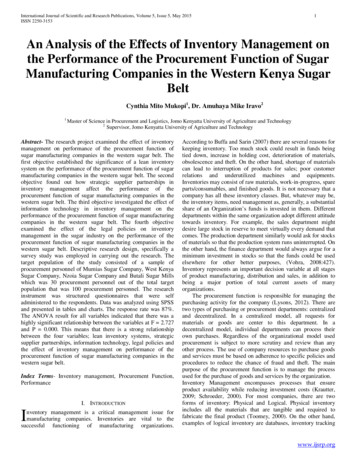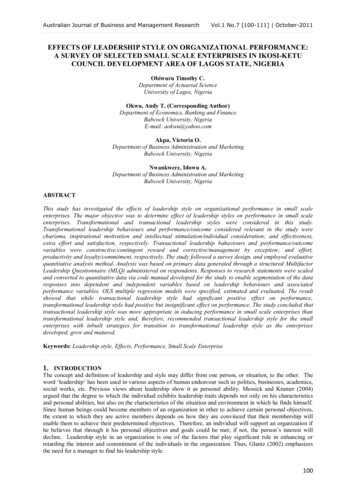
Transcription
Australian Journal of Business and Management ResearchVol.1 No.7 [100-111] October-2011EFFECTS OF LEADERSHIP STYLE ON ORGANIZATIONAL PERFORMANCE:A SURVEY OF SELECTED SMALL SCALE ENTERPRISES IN IKOSI-KETUCOUNCIL DEVELOPMENT AREA OF LAGOS STATE, NIGERIAObiwuru Timothy C.Department of Actuarial ScienceUniversity of Lagos, NigeriaOkwu, Andy T. (Corresponding Author)Department of Economics, Banking and FinanceBabcock University, NigeriaE-mail: aokwu@yahoo.comAkpa, Victoria O.Department of Business Administration and MarketingBabcock University, NigeriaNwankwere, Idowu A.Department of Business Administration and MarketingBabcock University, NigeriaABSTRACTThis study has investigated the effects of leadership style on organizational performance in small scaleenterprises. The major objective was to determine effect of leadership styles on performance in small scaleenterprises. Transformational and transactional leadership styles were considered in this study.Transformational leadership behaviours and performance/outcome considered relevant in the study werecharisma, inspirational motivation and intellectual stimulation/individual consideration; and effectiveness,extra effort and satisfaction, respectively. Transactional leadership bahaviours and performance/outcomevariables were constructive/contingent reward and corrective/management by exception; and effort,productivity and loyalty/commitment, respectively. The study followed a survey design, and employed evaluativequantitative analysis method. Analysis was based on primary data generated through a structured MultifactorLeadership Questionnaire (MLQ) administered on respondents. Responses to research statements were scaledand converted to quantitative data via code manual developed for the study to enable segmentation of the dataresponses into dependent and independent variables based on leadership behaviours and associatedperformance variables. OLS multiple regression models were specified, estimated and evaluated. The resultshowed that while transactional leadership style had significant positive effect on performance,transformational leadership style had positive but insignificant effect on performance. The study concluded thattransactional leadership style was more appropriate in inducing performance in small scale enterprises thantransformational leadership style and, therefore, recommended transactional leadership style for the smallenterprises with inbuilt strategies for transition to transformational leadership style as the enterprisesdeveloped, grew and matured.Keywords: Leadership style, Effects, Performance, Small Scale Enterprise1. INTRODUCTIONThe concept and definition of leadership and style may differ from one person, or situation, to the other. Theword „leadership‟ has been used in various aspects of human endeavour such as politics, businesses, academics,social works, etc. Previous views about leadership show it as personal ability. Messick and Kramer (2004)argued that the degree to which the individual exhibits leadership traits depends not only on his characteristicsand personal abilities, but also on the characteristics of the situation and environment in which he finds himself.Since human beings could become members of an organization in other to achieve certain personal objectives,the extent to which they are active members depends on how they are convinced that their membership willenable them to achieve their predetermined objectives. Therefore, an individual will support an organization ifhe believes that through it his personal objectives and goals could be met; if not, the person‟s interest willdecline. Leadership style in an organization is one of the factors that play significant role in enhancing orretarding the interest and commitment of the individuals in the organization. Thus, Glantz (2002) emphasizesthe need for a manager to find his leadership style.100
Australian Journal of Business and Management ResearchVol.1 No.7 [100-111] October-2011Among the objectives of any small enterprise are profit making and attainment of maturity and liquidity status.In the pursuit of these objectives, enterprises allocate scarce resources to competing ends. In the process theyprovide employment, provide goods and services, purchase goods and services and, thus, contribute to thegrowth of the society and economy at large. Unamaka (1995) observes that in most Nigerian small-scalesettings, the effectiveness of this process is greatly determined by the availability of and access to personnel,finance, machinery, raw material and possibility of making their goods and services available to their immediatecommunity and the nation at large.The extent to which members of an organization contribute in harnessing the resources of the organizationequally depends on how well the managers (leaders) of the organization understand and adopt appropriateleadership style in performing their roles as managers and leaders. Thus, efficiency in resources mobilization,allocation, utilization and enhancement of organizational performance depends, to a large extent, on leadershipstyle, among other factors. Akpala (1998) identifies attitude to work, leadership style and motivation as some ofthe factors that exert negative effect on organizational performance in Nigeria.Small and Medium Enterprise Development Agency of Nigeria (SMEDAN) in 2008, reports that most small andmedium scale businesses in Nigeria die before their fifth anniversary. Ashibogwu (2008) notes that one of thereasons for this high failure is lack of use of market research to confirm demand and assess suitability ofproposed offering as well as maintaining high level of customer patronage. Inappropriate leadership style couldbe one of the reasons for high failure of small enterprises.The study aligns with the concept of leadership as explained by Taffinder (2006) and, thus, considers leadershipwithin the context of a small-scale enterprise as the action of managers of the enterprise to contribute their bestto the purpose of the enterprise. A small scale enterprise is one with relatively small number of employees andlow capital strength. This study considers a small scale enterprise as one that has less than fifteen employees andwhose capital outlay is less than three million naira.From this consideration, this study is intended to evaluate the effect of leadership style on the performance ofsmall enterprises, contribute to empirical studies on leadership style and business performance, profferquantitative-based recommendations for policies and programmes to reposition the small scale enterprises atintegral part of the engine of economic growth and development in Nigeria.The study is divided into five sections. Section one is the introduction, section two is a review of relatedliterature, section three discusses the methodology employed in carrying out the study, and section four is datapresentation and analysis, while section five concludes the study and proffers recommendations for policy andentrepreneurial decisions.2. REVIEW OF RELATED LITERATURELeadership Style and PerformanceIn the literature, leadership has been identified as an important subject in the field of organizational behaviour.Leadership is one with the most dynamic effects during individual and organizational interaction. In otherwords, ability of management to execute “collaborated effort” depends on leadership capability. Lee andChuang (2009), explain that the excellent leader not only inspires subordinate‟s potential to enhance efficiencybut also meets their requirements in the process of achieving organizational goals. Stogdill (1957), definedleadership as the individual behaviour to guide a group to achieve the common target. Fry (2003), explainsleadership as use of leading strategy to offer inspiring motive and to enhance the staff‟s potential for growth anddevelopment. Several reasons indicate that there should be a relationship between leadership style andorganizational performance. The first is that today‟s intensive and dynamic markets feature innovation-basedcompetition, price/performance rivalry, decreasing returns, and the creative destruction of existing competencies(Santora et al., 1999; Venkataraman, 1997). Studies have suggested that effective leadership behaviours canfacilitate the improvement of performance when organizations face these new challenges (McGrath andMacMillan, 2000; Teece, Pisano and Shuen, 1997).On the other hand, organizational performance refers to ability of an enterprise to achieve such objectives ashigh profit, quality product, large market share, good financial results, and survival at pre-determined time usingrelevant strategy for action (Koontz and Donnell, 1993). Organizational performance can also be used to viewhow an enterprise is doing in terms of level of profit, market share and product quality in relation to otherenterprises in the same industry. Consequently, it is a reflection of productivity of members of an enterprisemeasured in terms of revenue, profit, growth, development and expansion of the organization.101
Australian Journal of Business and Management ResearchVol.1 No.7 [100-111] October-2011Understanding the effects of leadership on performance is also important because leadership is viewed by someresearchers as one of the key driving forces for improving a firm‟s performance. Effective leadership is seen as apotent source of management development and sustained competitive advantage for organizational performanceimprovement (Avolio, 1999; Lado, Boyd and Wright, 1992; Rowe, 2001). For instance, transactional leadershiphelps organizations achieve their current objectives more efficiently by linking job performance to valuedrewards and by ensuring that employees have the resources needed to get the job done (Zhu, Chew andSpengler, 2005). Visionary leaders create a strategic vision of some future state, communicate that visionthrough framing and use of metaphor, model the vision by acting consistently, and build commitment towardsthe vision (Avolio, 1999; McShane and Von Glinow, 2000). Some scholars like Zhu et al. (2005), suggest thatvisionary leadership will result in high levels of cohesion, commitment, trust, motivation, and henceperformance in the new organizational environments.Mehra, Smith, Dixon and Robertson (2006) argue that when some organizations seek efficient ways to enablethem outperform others, a longstanding approach is to focus on the effects of leadership. Team leaders arebelieved to play a pivotal role in shaping collective norms, helping teams cope with their environments, andcoordinating collective action. This leader-centred perspective has provided valuable insights into therelationship between leadership and team performance (Guzzo and Dickson, 1996). Some studies have exploredthe strategic role of leadership to investigate how to employ leadership paradigms and use leadership behaviourto improve organizational performance (Judge, Bono, Ilies, and Gerhardt, 2002; Judge and Piccolo, 2004;Keller, 2006; McGrath and MacMillan, 2000; Meyer and Heppard, 2000; Purcell, Kinnie, Hutchinson andDickson, 2004; Yukl, 2002). This is because intangible assets such as leadership styles, culture, skill andcompetence, and motivation are seen increasingly as key sources of strength in those firms that can combinepeople and processes and organizational performance (Purcell et al., 2004).Previous studies led the expectation that leadership paradigms will have direct effects on customer satisfaction,staff satisfaction, and financial performance. In general, however, the effects of leadership on organizationalperformance have not been well studied, according to House and Aditya‟s review (1997), who criticisedleadership studies for focusing excessively on superior-subordinate relationships to the exclusion of severalother functions that leaders perform, and to the exclusion of organizational and environmental variables that arecrucial to mediate the leadership-performance relationship. Another problem with existing studies on leadershipis that the results depend on the level of analysis. House and Aditya (1997), distinguished between micro-levelresearch that focuses on the leader in relation to the subordinates and immediate superiors, and macro-levelresearch that focuses on the total organization and its environment. Other scholars have also suggested thatleaders and their leadership style influence both their subordinates and organizational outcomes (Tarabishy,Solomon, Fernald, and Sashkin, 2005).Fenwick and Gayle (2008), in their study of the missing links in understanding the relationship betweenleadership and organizational performance conclude that despite a hypothesised leadership-performancerelationship suggested by some researchers, current findings are inconclusive and difficult to interpret.From this review of related literature, it is evident that although some scholars believe that leadership enhancesorganizational performance while others contradict this, different concepts of leadership have been employed indifferent studies, making direct comparisons virtually impossible. Gaps and unanswered questions remain.Consequently, the current study is intended to re-examine the proposed leadership-performance relationshipand, thus, contribute meaningfully to the body of growing literature and knowledge in this area of study.Theories of LeadershipAmong the various theories of leadership and motivation relating to effective organizational changemanagement, perhaps the most prominent is the transformational-transactional theory of leadership. Asexplained in Saowalux and Peng (2007), Burns (1978), conceptualizes two factors to differentiate “ordinary”from “extraordinary” leadership: transactional and transformational leadership. Transactional leadership is basedon conventional exchange relationship in which followers‟ compliance (effort, productivity, and loyalty) isexchanged for expected
and converted to quantitative data via code manual developed for the study to enable segmentation of the data responses into dependent and independent variables based on leadership behaviours and associated performance variables. OLS multiple regression models were specified, estimated and evaluated. The result showed that while transactional leadership style had significant positive effect




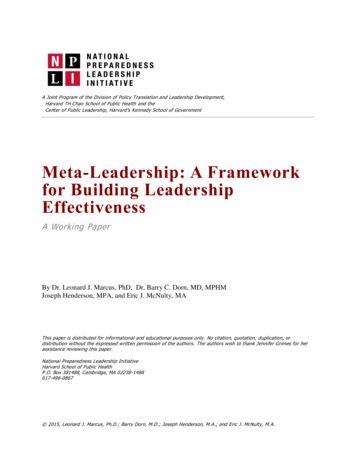

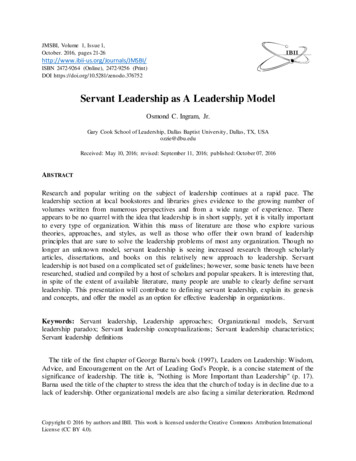
![[digital] Visual Effects and Compositing](/img/1/9780321984388.jpg)
